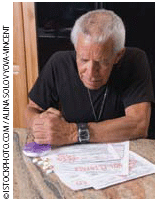The estimated total cost of cancer care in the United States is expected to reach $158 billion in 2020, according to a study published online January 12, 2011, in the Journal of the National Cancer Institute (JNCI).1 This 27% increase from 2010 is due mainly to the projected aging and growth of the US population.1
My colleagues and I were not surprised by the results—as the article’s authors observe, “Cancer disproportionately affects the elderly population, which is expected to increase from 40 million in 2009 to 70 million in 2030. With changes in risk factor prevalence and stage at diagnosis, and development of new diagnostic tools and treatments for cancer in the 1990s, in general cancer incidence declined and survival improved, but cancer care became more expensive.”1
How we will cope with this problem as a society remains to be seen. In the meantime, however, there is the issue of how to best help individual patients coping with the tremendous financial burden placed on them and their families as a result of rising treatment costs. The situation brings the need for patient relief programs into focus.
Foundations like the CancerCare Co-Payment Assistance Foundation (www.cancercarecopay.org), Healthwell Foundation (www.healthwellfoundation.org), Chronic Disease Fund (www.cdfund.org), and the Patient Access Network Foundation (www.panfoundation.org) provide essential financial help for people who cannot afford the insurance co-payments associated with treatment. Programs from pharmaceutical manufacturers and others provide free or low-cost medications to patients who are uninsured or do not qualify for other aid.
A new software tool, Patient Assistance Link (www.patientassistancelink.org), allows health care professionals as well as patients and caregivers to search for available co-payment assistance by diagnosis or specific medication. This recently launched tool is a significant milestone in the often fragmented realm of co-payment assistance. The health care professional or the patient completes a common standardized application and electronically submits it directly to the participating co-payment assistance foundations.
An example of how these programs help cancer patients is the case of Kathleen of Littleton, Colorado. Kathleen developed breast cancer in 2005. Her initial treatments included 6 months of IV infusions, followed by a mastectomy and radiation. Kathleen received financial assistance from the CancerCare Co-Payment Assistance Foundation, which provides up to $10,000 per year in co-payment assistance to eligible persons with insurance.
“[CancerCare] carried me through and allowed me to live my life, and not worry about how I was going to pay for my treatment,” says Kathleen. This type of support is invaluable for patients and families. And in this economic climate, the need for it is not likely to disappear anytime soon.
One issue the JNCI article does not address is the myriad of nonmedical expenses associated with treatment. For example, people coping with cancer and their caregivers can incur enormous transportation costs driving back and forth to the medical facility, or for taxi service or public transportation fares.
Kathleen, for instance, required frequent trips to and from the hospital for IV infusions and other treatments. She contacted CancerCare for financial guidance and learned that she qualified for a $100 grant from the organization, which she used to offset her transportation costs. “I never realized there was so much help available until all the bills started rolling in,” Kathleen recalls.
 There is indeed much help available for patients and families, but they often have to piece it together themselves. In addition to CancerCare (www.cancercare.org), diagnosis-focused organizations like the Leukemia & Lymphoma Society (www.leukemia-lymphoma.org) and the Patient Advocate Foundation’s Colorectal CareLine (www.colorectalcareline. org) provide transportation grants for people coping with cancer. The American Cancer Society’s Road to Recovery program (www.cancer.org) provides transportation to and from treatment in many communities for patients who do not have a ride, or are unable to drive themselves. The United Way (www.liveunited.org; or call 2-1-1) refers people to transportation services as well. Families who require air transportation to a treatment facility can contact the National Patient Travel Center (www.patienttravel.org), a referral service that connects patients to medical air transportation providers.
There is indeed much help available for patients and families, but they often have to piece it together themselves. In addition to CancerCare (www.cancercare.org), diagnosis-focused organizations like the Leukemia & Lymphoma Society (www.leukemia-lymphoma.org) and the Patient Advocate Foundation’s Colorectal CareLine (www.colorectalcareline. org) provide transportation grants for people coping with cancer. The American Cancer Society’s Road to Recovery program (www.cancer.org) provides transportation to and from treatment in many communities for patients who do not have a ride, or are unable to drive themselves. The United Way (www.liveunited.org; or call 2-1-1) refers people to transportation services as well. Families who require air transportation to a treatment facility can contact the National Patient Travel Center (www.patienttravel.org), a referral service that connects patients to medical air transportation providers.
For families who must travel long distances for treatment, the next financial hurdle they may encounter is overnight lodging. The American Cancer Society’s Hope Lodge provides free lodging for people affected by cancer and their families. Joe’s House (www.joeshouse.org) and the National Association of Hospitality Houses (www.nahhh.org) are lodging referral resources for patients and their families.
Over-the-counter (OTC) medications are another added expense for the person coping with cancer. CancerCare offers grants to pay for these medications, as does the Partnership for Prescription Assistance (www.pparx.org), Needy Meds (www.needymeds.org), the Leukemia-Lymphoma Society, and the Colorectal CareLine. Women who need a wig or breast prosthesis can contact organizations such as CancerCare, Y-ME National Breast Cancer Organization (www.y-me.org), and Pink Heart Funds (www.pinkheartfunds.org). Area Agencies on Aging and the federally funded LIHEAP (Low-Income Home Energy Assistance Program; www.liheap.org) connect older adults with programs that provide financial assistance with the cost of utilities.
Patients can learn about additional financial resources for expenses not directly related to their treatment, along with other types of financial help such as scholarships, by visiting the website of the Cancer Financial Assistance Coalition (CFAC) (www.cancerfac.org). CFAC is an alliance of 14 organizations that maintains a comprehensive database of financial assistance programs on the local and national levels.
Oncology nurses can make a tremendous difference for their patients by making the topic of finances an integral part of the dialogue. Too many patients are not aware of the financial resources that are available, and do not realize that the costs of cancer care, no matter how closely related to their treatment, is something that can and should be discussed with their health care team. ONA
Helen Miller is CEO of CancerCare.
REFERENCE
1. National Cancer Institute. Cancer care costs in the United States: projections 2010-2020. J Natl Cancer Inst. 2011;103(2). http://jnci.oxfordjournals.org/ content/103/2/NP.2.full. Accessed March 15, 2011.
